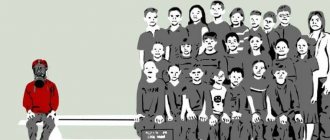Socialization of the individual – a person’s mastery of basic social norms, values, culture, standards of relationship models in the society to which the individual belongs. It consists of accepting and mastering the values, morals, norms of behavior, and knowledge prevailing in society. Socialization contains agents and institutions that specialize in the processes of introducing an individual to society.
Socialization is divided
:
- Primary – mastery of a basic set of values and behavior patterns in society by a child;
- Secondary – mastery of a new value-normative basis by an adult individual.
What it is
Every person is part of society; few people can live outside of social groups. Therefore, in the process of socialization, norms of behavior, cultural values, and behavior patterns are learned. How an individual will exist in society depends on this.
There is primary and secondary socialization. The first refers to the formation of personality from birth to adulthood, the second refers to the assimilation of values by an adult.
The development process occurs under the influence of agents and institutions. The first group includes people who are responsible for training. For example, these are parents and teachers. The second group concerns special institutions that are responsible for socialization.
The process never ends and lasts a person’s entire life. It can be roughly divided into several stages. All of them occur regardless of the individual’s desire.
Stages of the process of personality socialization according to Erikson
Erik Erikson is a renowned developmental psychologist and psychoanalyst. According to him, there are the following stages of the socialization process:
| 1 | Infancy (from birth to one and a half years). At the earliest stage of socialization, the formation of basic trust in the world occurs. The main role in this is played by the child’s mother, and the dynamics of the development of trust depend on her. If there is too little communication with the mother, the child’s psychological development will slow down. |
| 2 | Early childhood (from 1.5 to 4 years). The child’s independence and autonomy are being formed. The child begins to walk, can already clean up his toys, etc. Parents gradually teach their child to be neat and tidy. |
| 3 | Childhood (from 4 to 6 years). During the game, the child develops a sense of enterprise and initiative, he develops his creativity, memory, logical thinking, and gains ideas about the interaction of people with each other. He is actively expanding the scope of his knowledge about the world. If you deprive a child of the opportunity to develop and socialize through play, this will be reflected in passivity, lack of initiative and lack of self-confidence in the future. |
| 4 | Junior school age (from 6 to 11 years). At this stage, socialization no longer occurs only with the participation of parents. The school introduces the child to the norms of behavior, and in communicating with classmates he receives the social experience he needs. Success or failure in studies can affect the further development of the individual. If, for example, a child is unable to study, and instead of help he receives reproaches from teachers and parents, this can lead to uncertainty, loss of interest in studies and even a feeling of inferiority. |
| 5 | Adolescence (from 11 to 20 years). At this stage, the individual is very concerned about how he appears to the people around him. This is partly due to puberty. A teenager faces the need to self-determinate and find his professional calling. |
| 6 | Youth (from 21 to 25 years old). A person is looking for a life partner, actively interacting with other people, especially within his social group. Feelings of closeness and unity with other people appear, and often the individual begins to identify himself with a social group. At the same time, due to an identity crisis, a person often feels lonely and isolated. |
| 7 | Maturity (from 25 to 55-60 years). A person invests himself in what he loves and develops a sense of identity. Interaction with other people, especially children, is of great importance. |
| 6 | Old age (from 55-60 years to death). This stage is characterized by rethinking one’s life and reflecting on the past years. A person understands that life is coming to an end. In this regard, he can distance himself from what is happening around him. |
Of course, this topic is much broader and interesting, and it is unlikely that it will be possible to talk about everything in one article. However, what has been said is already quite enough to get an idea of socialization, as well as draw certain conclusions about your development and the development of your children.
We hope you found this article helpful. We wish you success!
We also recommend reading:
- Storytelling
- Psychosocial development theory
- The role of art in children's development
- Personality criteria
- “I-concept”: characteristics, features, meaning
- Formation of self-esteem in children
- Formation of self-awareness
- Piaget's theory of cognitive development
- Social setting
- Eric Berne "People Who Play Games" - summary
- Social groups: signs, types, functions
Key words:1Self-knowledge
Kinds
Socialization - what it is, how it is viewed
In psychology, it is customary to highlight options for socialization. For example, during sexual intercourse, different gender roles are learned: girl, girl, woman. The family-household form provides opportunities to learn social roles: daughter, mother, wife, etc. The boy takes on the role of son, husband, father and others.
Primary socialization
This type can also be called children's. The process is unconscious; the child is influenced by various environmental factors. It is under their influence that norms of behavior are learned. Parents, relatives, and educators act as guides.
The older the child, the more awareness he begins to show. In age periods this has its own characteristics. For example, a teenager may reject generally accepted norms and behave antisocially. He is faced with a choice of which line of behavior to choose.
The family is the first place where a child develops ideas about approved actions
Scientists were able to prove that primary socialization is possible only under the influence of external factors. Example - Mowgli children (kids who grew up with animals) can adapt to society only until they are 9 years old, then they forever lose the opportunity to return to a normal lifestyle.
Secondary socialization
As we grow older, the process of assimilation of social norms does not stop. A person undergoes secondary socialization, i.e. getting used to different teams. For example, when an individual enters college or university, he has to learn new behavior patterns.
Important! The most difficult process is when moving to another country, as you have to change habits and traditions.
The socialization process is not always easy. In some situations, a person needs the help of a psychologist.
Permanent socialization
Any society is not a permanent entity. Changes occur in it that affect socialization. For example, a couple of centuries ago women did not have many rights, but in the modern world they are already endowed with a large number of privileges.
Changes also occur in the life of every individual. He can choose a new field of activity, move to another city. In society, ideals become obsolete and other values appear. If the process happens gradually, then it is not so stressful.
Everything is different when the changes are revolutionary. In this case, not all people will be able to integrate into the new society. Individuals who have a flexible psyche will most easily cope with the situation. If socialization goes poorly, a person feels rejection and discomfort.
Features of socialization of children with disabilities
The socialization of children with disabilities - disabilities - provides for their right to diagnosis, special programs of psychocorrectional work, organizational and methodological assistance to families, differentiated and individual education. For children with special educational needs the following are created:
- Specialized preschool educational institutions, schools or correctional classes in regular schools.
- Health educational institutions of sanatorium type.
- Special correctional educational institutions.
- Educational institutions for children in need of psychological, pedagogical and medical and social assistance.
- Educational institutions of primary vocational education.
Opportunities for obtaining secondary vocational and higher vocational education are being created for children with disabilities. For this purpose, special educational institutions are created, and various forms of integration are provided for in general institutions.
Despite this, the problem of socialization of children and adolescents with disabilities continues to remain relevant. The question of their integration into the society of “healthy” peers raises a lot of controversy and discussion.
Differences between species
Adaptation - what is it in psychology
Primary and secondary socialization differ not only in age. These two processes have a number of features. Thus, the concept of “primary socialization” refers to the process of forming basic values, while during the secondary assimilation of information, behavioral norms are adjusted.
Important! Children can only assimilate the attitudes accepted in society. Adults decide for themselves whether to accept them or not.
A child’s social life is expressed in the development of certain behavior patterns. The older a person is, the more clearly he understands the conventions of certain norms. For an adult, the process is aimed at mastering new skills that will help in life.
Mechanisms
Every society has socialization mechanisms through which people convey information about social reality to each other. In sociological terms, there are some “translators” of social experience. These are means that transmit accumulated experience from generation to generation, contributing to the fact that each new generation begins to socialize. Such translators include various sign systems, cultural elements, educational systems, and social roles. Socialization mechanisms are divided into two categories: socio-psychological and socio-pedagogical.
Socio-psychological mechanisms:
- Imprinting is the imprinting of information on the receptor and subconscious levels. More common in infancy.
- Existential pressure - the assimilation of language and norms of behavior at an unconscious level.
- Imitation is following a model, voluntary or involuntary.
- Reflection is an internal dialogue during which a person critically thinks about and then accepts or rejects certain social values.
Social and pedagogical mechanisms:
- Traditional - a person’s assimilation of prevailing stereotypes, which occurs, as a rule, at an unconscious level.
- Institutional - triggered by a person’s interaction with various institutions and organizations.
- Stylized - functions when included in any subcultures.
- Interpersonal - turns on whenever there is contact with persons who are subjectively significant to a person.
Stages
Personality development - what is it in psychology
A person develops throughout his entire existence. Therefore, the process occurs in several stages.
In psychology, there are special exercises that help facilitate the assimilation of behavioral norms.
Adaptation
This is the beginning of the process, during which a person learns basic norms of behavior. In children's society, the stage passes on its own, in adults it requires activity from the individual.
This period is characterized by the internalization of social norms - the learned rules pass into the inner world of a person, i.e. they become self-evident for him and do not cause rejection.
Personalization
It often manifests itself clearly in adolescents. At this stage, the person has already mastered the usual norms of behavior, but he does not want to follow them. He needs to prove himself, to be a unique personality. In this case, the individual is prone to asociality and destructiveness.
Important! Under unfavorable circumstances, a person commits suicide, engages in criminal activity, etc.
At this time, the child goes through the process of defining himself as a unique individual. He tries different areas of activity, chooses interesting activities for himself.
Integration
Usually coincides with the stage of becoming a specialist. A person understands where he needs to direct his energy and looks for people who will share his point of view.
At this stage, the individual is able to make achieving success a primary aspiration. He demonstrates his talents, his goal is to realize his skills. He has a desire to become significant for society.
Spheres
The main areas in which an individual masters social connections are activity, communication and self-awareness.
In the process of activity, a person’s horizons regarding various types of activities expand. Next, this new information is structured, and then the person focuses on a certain type of activity as the main one, the main one at this stage. That is, a hierarchy is built, comprehension occurs, and the central type of activity is determined.
Communication expands and enriches a person’s connections with the public. Firstly, there is a deepening of forms of communication, that is, a transition from monologue to dialogical communication. What does it mean? The fact that a person learns to decenter, to take into account the point of view of another as an equal communication partner. An example of monologue communication is the catchphrase and half-joking expression: “There are two points of view on this matter - mine and the wrong one.” Secondly, the circle of contacts increases. For example, with the transition from school to college, the process of mastering a new environment begins.
As a person masters new types of activities and new forms of communication, he develops his own self-awareness, which is understood as a person’s ability in general to distinguish himself from others, the ability to recognize himself as “I” and, along the way, develop some kind of system of ideas about life, about people, about the world around us. Self-awareness has three main components:
- Cognitive self is knowledge of some of one’s own characteristics and ideas.
- Emotional Self - is associated with a general assessment of oneself.
- Behavioral self is an understanding of what style of behavior, what modes of behavior are characteristic of a person and which ones he chooses.
As socialization occurs, self-awareness grows, that is, understanding oneself in this world, one’s capabilities, one’s preferred strategies of behavior. It is very important to note here that as self-awareness grows, a person learns to make decisions and choices.
Making decisions is a very important moment of socialization, because only adequate decisions allow a person to subsequently perform fairly adequate actions in the world around him.
Taken together, activity, communication and the development of self-awareness represent a process during which a person masters the expanding reality around him. It begins to unfold before him in all its diversity and in all its complexities.
Stages
In psychology, it is customary to distinguish several stages of socialization development. The classification is based on the socio-economic aspect.
The first level is pre-labor. It includes the assimilation of basic norms and behavior patterns. The process takes place under the influence of educational factors.
The second level is labor. The individual develops all his abilities and undergoes professional guidance. A social role and status is being formed.
The third level is post-labor. Starts after retirement. At this time, new skills of existence are consolidated, the old system of ideas becomes obsolete. A person is forced to look for new ways of self-expression. Differences between stages reveal the degree of socialization of a person.
Different approaches
In total, there are two concepts in psychology. According to the first, the essence of socialization lies in the fact that society itself is interested in uniform norms of behavior.
In a work team, everyone has their own role; mastering the rules allows you to increase productivity
A similar theory was adhered to by J. Ballantyne, T. Parsons and others. Another concept is based on the idea that during socialization an individual undergoes internal changes. A similar idea belongs to J. Mead.
The essence of socialization
The need for socialization is determined by human nature itself. He is a unique phenomenon, because he is the only living creature that has virtually no innate forms of behavior. A child who has not undergone socialization is unable to communicate as a person, establish relationships with relatives, or behave as is customary in society. It is a cat or a dog that has innate programs of species behavior, but a person needs to learn everything.
Socialization, in essence, is the process of human adaptation in society. But this is not just knowledge of how to behave in a given situation. Knowledge of social norms does not guarantee compliance with them. For example, a criminal does not steal because he does not know that it is illegal. He knows this very well. But the norm “don’t steal” did not go through the process of socialization, was not appropriated by him, and did not become his intrapersonal norm of behavior. The phenomenon of transition of a social norm or meaning from the external to the internal level is called internalization.
This is the basis of socialization, its basic process. Initially, all norms of behavior and methods of social activity are external for the child. Parents, sometimes through persuasion and sometimes through coercion, instill in their child the habit of performing certain actions, making assessments of their own actions and the actions of others. For example, a small child does not feel any need to eat with a spoon, fasten buttons on his blouse, brush his teeth, say hello, much less put away his toys. But if the parents are persistent and patient enough, then these actions become habitual, and in a similar situation the child himself will feel the need for them. So, we, adults, will experience obvious discomfort if we have to eat salad with our hands or go out to strangers casually dressed.
The complexity of socialization also lies in the fact that a person is a member of different social groups with different norms and rules. We have to undergo additional socialization in every society we happen to find ourselves in.
Resocialization
In the life of any person, roles change, and new patterns of behavior have to be adopted. This process does not always lead to a positive result.
Resocialization is the inability to internalize certain norms. Because of this, personal changes do not occur and a person’s life does not improve. His value system remains the same as before; he cannot define new goals for himself.
When in this state for a long time, an individual is capable of dramatic changes, for example, emigration, changing religion, profession, etc. Such a process is not always negative; retraining can be beneficial for personal development.
Features of socialization are considered within the framework of a subject such as social studies. It identifies the characteristic features of all stages, their course, on which the speed of assimilation depends.
In pedagogy, teachers study ways to speed up the process - this makes it easier to form a team
Techniques that make it easier for a newcomer to join a work group are used by all large firms. The effectiveness of the activity depends on how quickly this stage passes.
In political science, the term is understood as the process of acquiring political knowledge, skills, and norms. This allows you to adapt to the existing political system.
Socialization involves the assimilation of norms that are accepted in a certain group. The science of sociology studies this phenomenon. It collects all the current data and statistics that reflect the characteristics of the current society.
Diagnostics
Diagnostics of socialization is one of the tools for understanding the phenomenon, which is also considered as a method of creating conditions for further acquisition of socialization skills.
Socialization diagnostic functions:
- information and prognostication. It consists of analyzing data showing the level of socialization of a person. They are also the starting point for creating conditions for further socialization;
- evaluative and effective. It consists of assessing the results of work, finding effective ways to solve social and pedagogical problems;
- correctional and formative. It consists in providing the opportunity to simultaneously identify shortcomings and deviations in activity and timely correct it for the most effective socialization.
Criteria for socialization of an individual when diagnosing a phenomenon include:
- Cognitive components (a person’s knowledge of problems in the social sphere, rates of progress in socialization).
- Emotional-volitional components (a person’s attitude towards his own and others’ nationality, society and work activity).
- Behavioral components (propensity for collectivism, degree of activity, involvement in relationships with people).
There are many psychological tests for different age groups that allow one to determine the level of socialization of an individual and identify the presence of traumatic factors in the process of its development.
For example, the test “Levels of Personal Socialization”, placed in the textbook, which was developed by Candidate of Philosophical Sciences R.I. Mokshantsev and finalized by candidate of psychological sciences T. A. Bondarenko.
The test allows you to assess the levels of socialization of an individual and identify psychological trauma that may have occurred while growing up. The test includes first-person questions about a person’s internal state and his attitude to life situations; response options reflect the person's agreement or disagreement.
As for assessing the socialization of school students, it is possible, developed by M. I. Rozhkov, Doctor of Pedagogical Sciences.
The purpose of monitoring is to identify the level of social adaptation, activity, autonomy and moral education of students. The essence of the test is for participants to listen to 20 statements, for which they must mark their agreement or disagreement with the statements.











